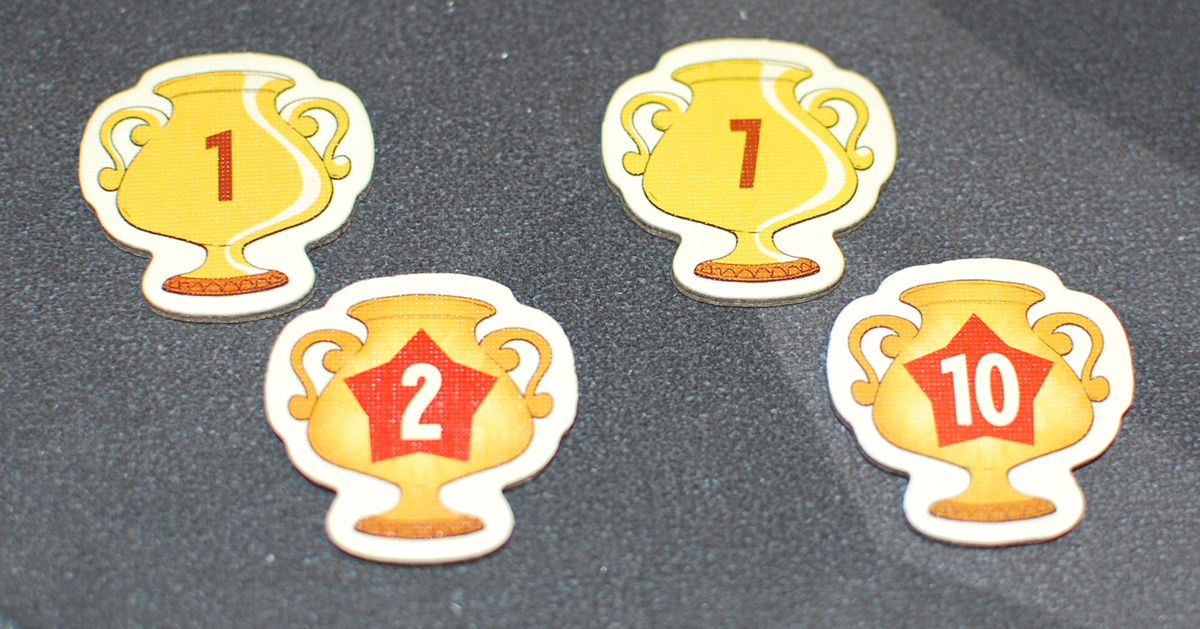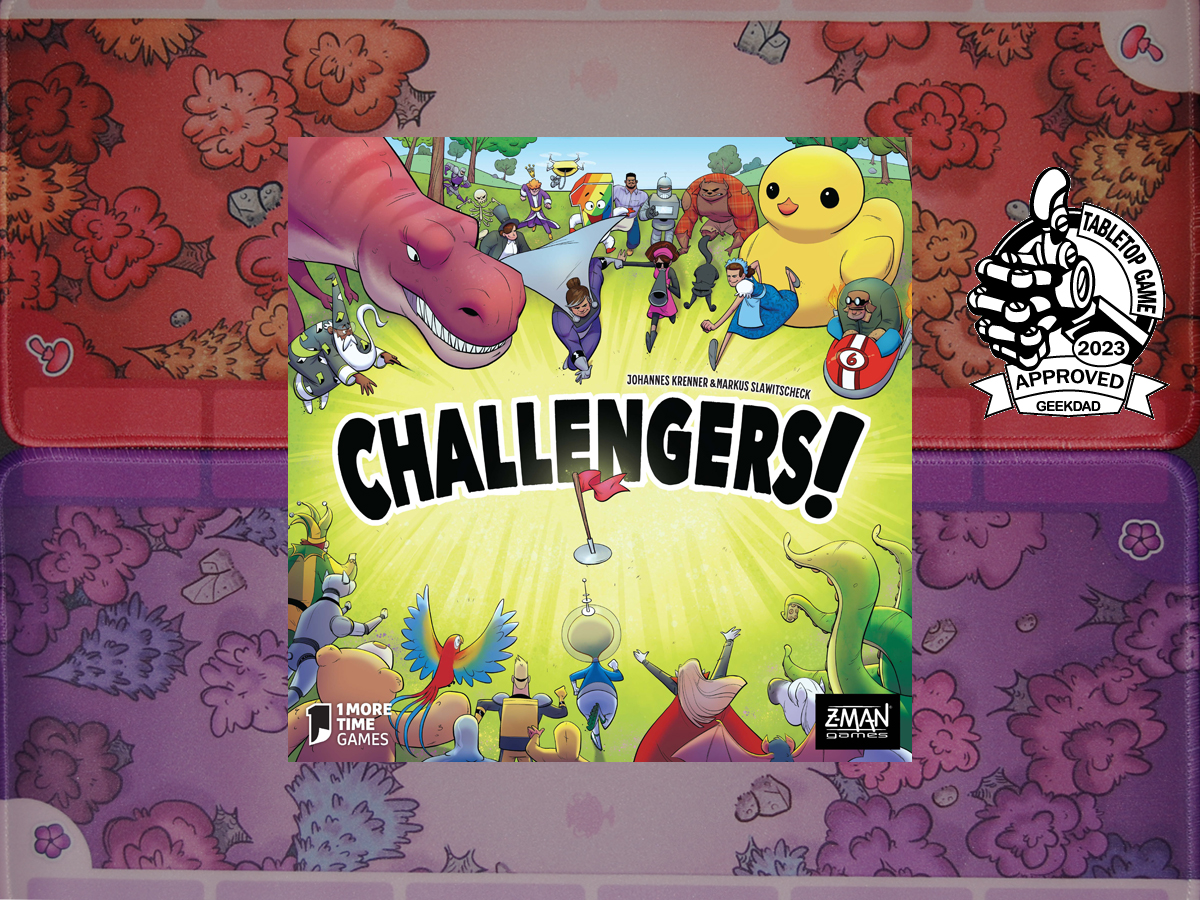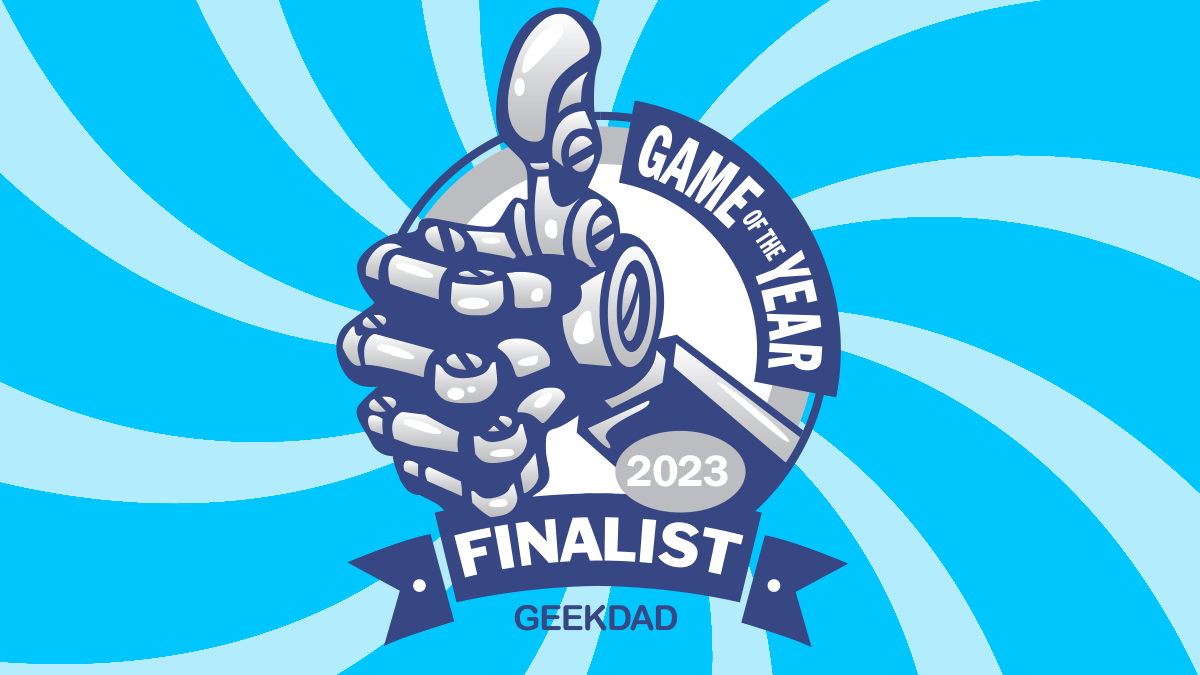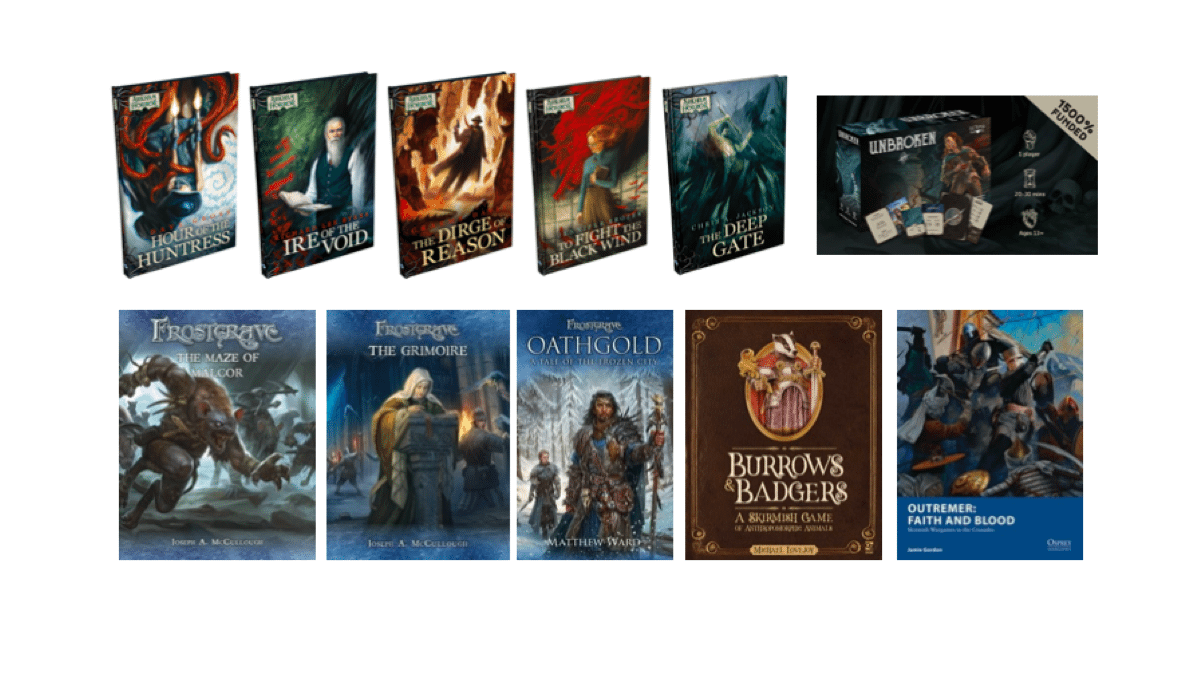Build your roster of wacky teammates in this capture-the-flag tournament card game.
What Is Challengers!?
Challengers! is a card game for 1 to 8 players, ages 8 and up, and takes about 45 minutes to play. It debuted at Essen SPIEL in October 2022 and then saw a US release in November 2022. Challengers! retails for $39.99 and is available in stores and online, including directly from Z-Man Games. While it can accommodate any number of players from 1 to 8, I think it shines particularly with an even number of players, the more the better. The theme is a cartoony capture-the-flag tournament and the rules are simple enough for kids to pick up, so I think the 8+ age rating is about right.
Challengers! was designed by Johannes Krenner and Markus Slawitscheck and published by 1 More Time Games (and by Z-Man Games in the US), with illustrations by Jeff Harvey.

Challengers! Components
Here’s what comes in the box:
- 4 Park mats
- 4 Flag tokens
- 3 Card trays
- 40 Fan tokens (in 1 and 3 values)
- 28 Trophy tokens
- 9 Tournament Plan cards
- 8 Starter Decks (6 cards each)
- 20 Basic City cards
- 40 Castle cards
- 40 Funfair cards
- 40 Outer Space cards
- 40 Film Studio cards
- 40 Haunted House cards
- 40 Shipwreck cards
- 19 Robot cards

As you can see, the game is primarily cards, with a few tokens. Each card has a base value and a name, along with a set icon. Many of the cards have additional abilities on them, though some simply say “Rare” with a number indicating that there are only so many of them in the deck. The characters range from movie stars to necromancers to giant rubber ducks, and the illustrations are a lot of fun.
The park mats are neoprene mats, and are pretty nice: they have stitched edges and each one is illustrated with a top-down view of field with trees on the edges. They have different colors but each also has a unique icon as well. The two long edges of the mats have spaces for six cards each. The flag tokens (one for each park) are chunky plastic disks with a flag icon, black on one side and white on the other in case you need to flip to see who goes first.

The card trays are simple plastic trays with a horizontal shelf to hold the deck, and a pocket on the end to hold the discard pile. While they’re not strictly necessary, it definitely makes it easier to track the three decks and discards without having things get too mixed up.

The trophy tokens and fan tokens are cardboard that you’ll need to punch out before you play. The trophies are numbered from 1 to 7 on the front, and have varying numbers of fans (the number in the red star) on the backs. My only complaint about these is that in the typeface they used, the 7 looks a lot like a 1, and I’ve often had players get them mixed up until I point it out. The fan tokens are little stars, and they were a little harder to punch out because of the sharp corners. There’s also a lot of them but I’ve rarely played games where we needed more than just a few of them so they seem unnecessary—but then again if several people pick characters that gain fans, then you’ll need a bunch.
How to Play Challengers!
You can download a copy of the rulebook here.
The Goal
The goal of the game is to gain the most (or second-most) fans in a 7-round tournament, and then win the final showdown match.

Setup
Give each player a starting deck and a tournament plan. The plan cards are organized by the number of players, so be sure to use the correct set!
Set up the parks: set out the mat and the matching flag token, and make a stack of trophy tokens with “1” on the top and “7” on the bottom. Set the fan tokens nearby as a supply. (The rulebook illustration has the mats lengthwise between players, but I like to have the mats horizontally so that each player’s bench cards are facing them instead of turned sideways.)

Set up the decks: you always use the basic city set, and then add in 5 additional factions. The cards are sorted into the A, B, and C levels, and each level is shuffled individually and placed in its corresponding tray.1
Gameplay
The game consists of 7 matches and then a final showdown between the top two players. Each match has a deck phase and then a match phase.

During the deck phase, you draw 5 cards from the appropriate deck (indicated on the tournament card), and add up to two of them to your deck. You are allowed one mulligan per deck phase, where you can discard and re-draw. Each round you will be able to add one or two cards to your deck. You may also remove any number of cards from your deck, discarding them back to their appropriate trays (or to the box, in the case of starter cards). Shuffle your deck and don’t peek at the order or rearrange them!
After the deck phase, find your park. Your tournament card will show a park icon in either light or dark, indicating which side of the field you’ll be on, and you will play a one-on-one match against an opponent. Whoever has the most recent trophy will go first, and if there’s a tie then you flip for it.

The first player reveals their top card and places the flag token on it—it is now in “flag possession.”
You will take turns “attacking” until you gain the flag: play cards off the top of your deck until your total power meets or exceeds the card in flag possession. Take the flag and place it on your most recent card, which is now in flag possession (and the other cards no longer count). Your opponent’s cards are placed on the bench (the side of the park mat); all cards with the same name can be placed on the same seat. Now your opponent will attack to attempt to take the flag back.

Many cards have special abilities that will trigger based on different conditions, such as gaining strength during the attack or during flag possession, or giving you abilities when the card is played or when it loses the flag. There are cards that let you peek ahead at your deck and rearrange cards, and some that will remove cards from your bench to make more room.

If your opponent runs out of cards before they take the flag back, then you win the match. Or, if your opponent needs to put cards on their bench but there aren’t enough empty seats available, you win. Take the top trophy from the stack—you may look at the number of fans on the back but keep it secret from other players. Collect up all of your cards, and go to the deck phase for the next match.

The Bot Player
If you have an odd number of players, at some point during the tournament you will play against the robot deck. The robot also has a tournament card and uses a starting deck of S cards, though you may sub in some of the R cards to make it more difficult. The robot does not add new cards during the deck phase but just uses the same deck each time—however, it has some Cyborg cards that get stronger each round.
Game End
After 7 matches, all players reveal their trophy tokens and add up all their fans (including fan tokens they may have gained during the matches). The two players with the highest total will face each other in the final. (In case of a tie, it’s the player with the single trophy with the highest round number.)
Before the final showdown, the two finalists may remove cards from their decks but will not add any more. The winner of the final match is the champion of Challengers!
Challengers! is a 2023 Game of the Year Finalist!
Why You Should Play Challengers!
When I first read the rules for Challengers!, I thought, hmmm, this just seems like a glorified game of War. You know, that classic card game where you each get half the deck, you flip over the top card, and the higher card wins. You get to modify your deck, but then you just shuffle it up and play cards off the top? It seemed too simple.
Well, as you may have suspected from that GeekDad Approved seal up above, it turns out there’s a bit more to Challengers! than I’d first expected. The trick is in the cards that you add to your team, and the variety of powers and effects that they have when played. To be sure, there’s still a bit of luck, both in the card draws for the deck-building and in the order that cards are played during the matches, but it turns out that the game isn’t just a game of chance.
Now, the first bit of luck you can’t change too much: if you don’t like the five cards you’ve drawn, you can discard them and try again. That gives you up to ten cards to look at in a round, which still might get you exactly what you’re looking for. Still, part of the challenge is making the most of what you get, rather than being able to build the same team every time you play the game. In some rounds, you’ll get a choice between two different decks—for instance, adding two cards from deck A or one card from deck B. That gives you options: deck B has more powerful cards, but drawing from deck A might give you the opportunity to add more duplicates, which is handy for not overflowing your bench.

The second type of luck—the random draws during the match—is something that you may be able to control a bit more. Although the default is to play through your deck in order, there are many cards that affect this. The Clairvoyant lets you look through your entire deck and choose one card to put on top; the Navigator lets you peek at the top two and put one on top and one on bottom. With enough of the deck-manipulation cards in your deck, you’ll have many opportunities to rearrange things and perhaps set up some combos.

Another type of ability to watch for is the set synergies. While they don’t all trigger the same way, each set has some cards that reward having other cards of the same set. The Vendor gives all of your funfair cards +1 when she’s on the bench; the Merman is stronger if you already have any shipwreck cards on your bench when he’s played. There are also cross-set synergies that depend on the values instead, like the Stable Boy who gets stronger if there are cards with a base value of 3 on your bench.

Building a good team requires a balance of having enough cards that you don’t run out before you can capture the flag, but not so many unique characters that your bench overflows. There are some cards that will help you with that, removing cards from your bench either to an exhaust pile (like a temporary discard) or putting cards back onto your deck. There are even cards that will mess with your opponent, putting cards from their deck onto their bench to accelerate their overflow. On the first round, you don’t really have to worry about overflow because you’ll have at most six different characters, but after that you’ll need to think about which characters to remove as well as which ones you’re adding.
The matches themselves are generally pretty quick, though the deck-manipulation abilities can slow things down a little if somebody has a lot of them. It’s where you get to see how your deck plays out. Some teams seem to function fairly well no matter what order you put them in, but most of the time there are at least a couple cards where the timing is key. If your Butler—who can clear two cards from the bench—comes out at the beginning of the match, he’s wasted because there aren’t cards to clear yet. Others, like the Lifeguard, are more valuable if they appear near the end. Either way, the game is great at creating memorable moments: the edge-of-your-seat tension as you see if the last few cards are enough to take back the flag, the groans when you draw a huge number when you only need a small one, the relief when you win just before your bench overflows.
I also really love the fact that you get up and move around from park to park—it just adds a little bit of activity and it’s fun to shift seats and wait to see who you’re up against. (I’ll note that there is one tournament card that stays in place, so if you have somebody who does not like playing musical chairs, you can give them that card and they can stay put.) In an 8-player game, you’ll face each opponent once, but if you have fewer players you’ll have some repeats. That’s partly why I prefer the full player count, simply because you get to see lots of different teams over the course of the game.
The robot player, used in odd player counts, is fine enough. Because of the Cyborg card, its power scales up pretty well so that it’s not a pushover but can still be beat. However, because the robot deck doesn’t change between matches, it can feel a bit more boring. You don’t get that surprise of discovering who your opponent has drafted to their team.

Challengers! is quickly becoming one of my favorite quick games, particularly for a big group. At a recent local gaming convention, we managed to run a few 8-player games of it, and I love the way it really does give you the feel of a tournament in under an hour. It rewards skillful team-building, but there’s still enough luck that there can be spectacular upsets. Since the later trophies have more fans, you also don’t feel locked out of the game if you don’t win your first few matches.
If you’re looking for a fast, lighter game that accommodates a big crowd, Challengers! is a definite winner.
For more info or to order a copy, visit the Z-Man Games website.
Click here to see all our tabletop game reviews.
![]() To subscribe to GeekDad’s tabletop gaming coverage, please copy this link and add it to your RSS reader.
To subscribe to GeekDad’s tabletop gaming coverage, please copy this link and add it to your RSS reader.
Disclosure: GeekDad received a copy of this game for review purposes.







